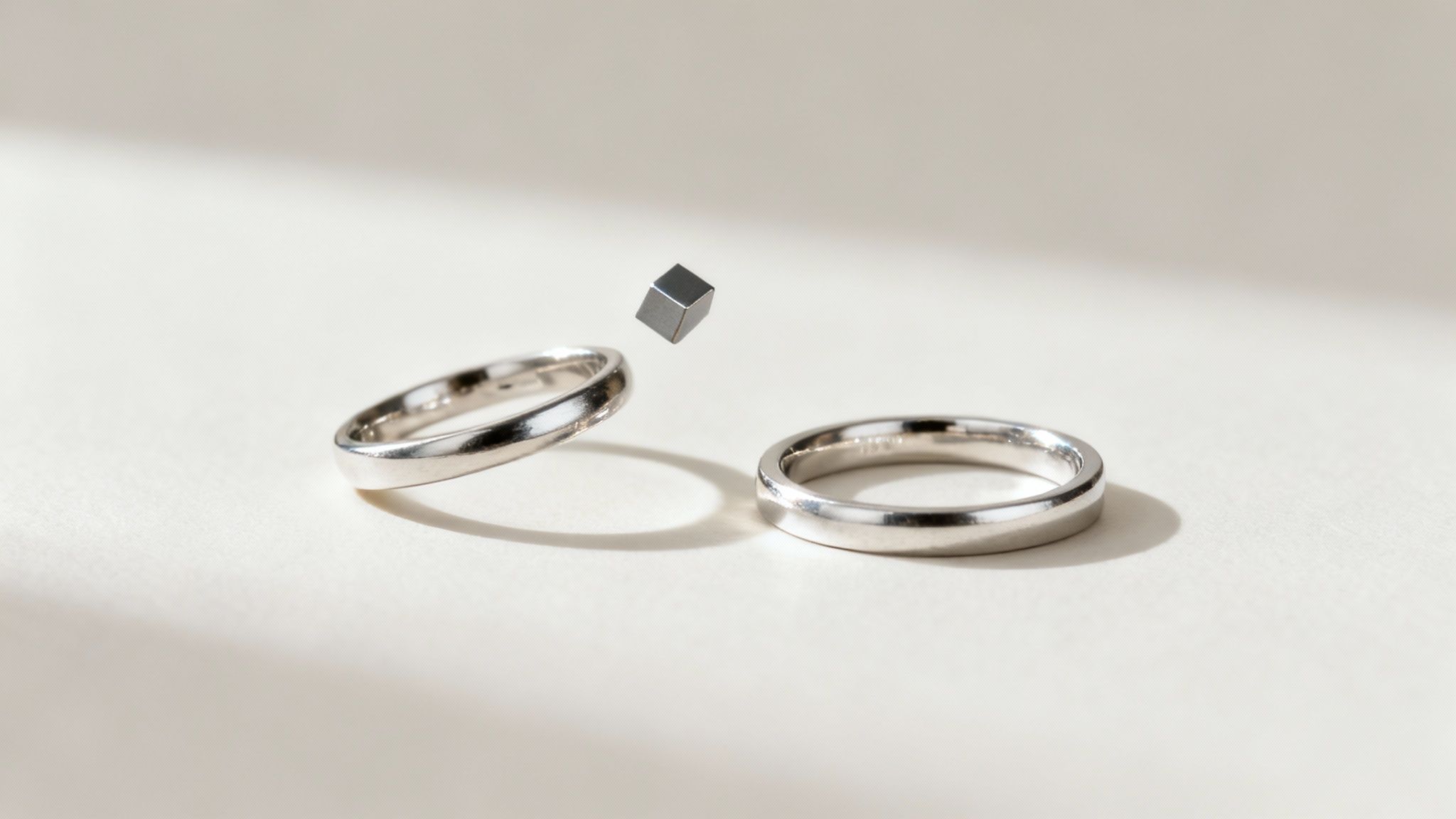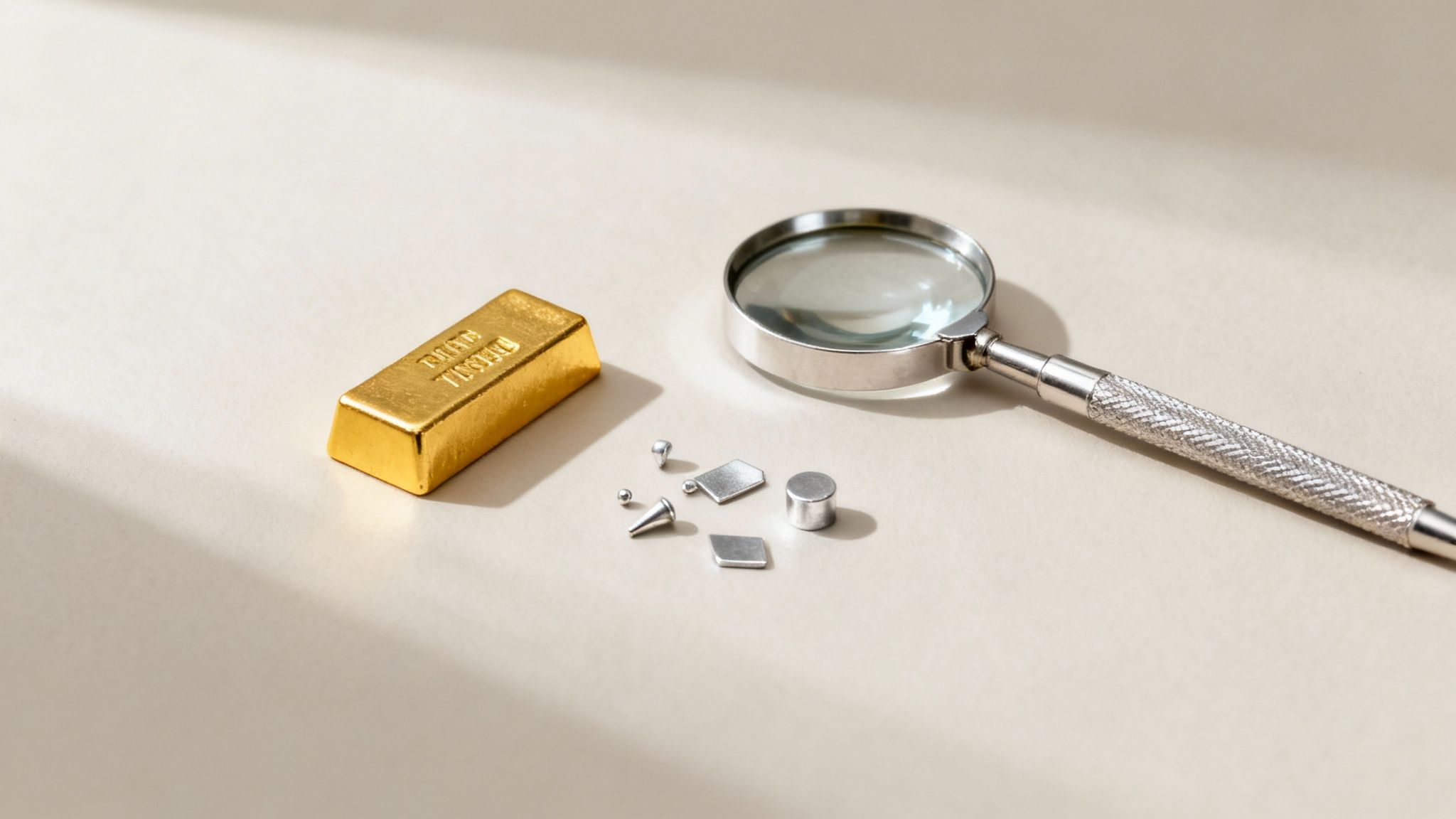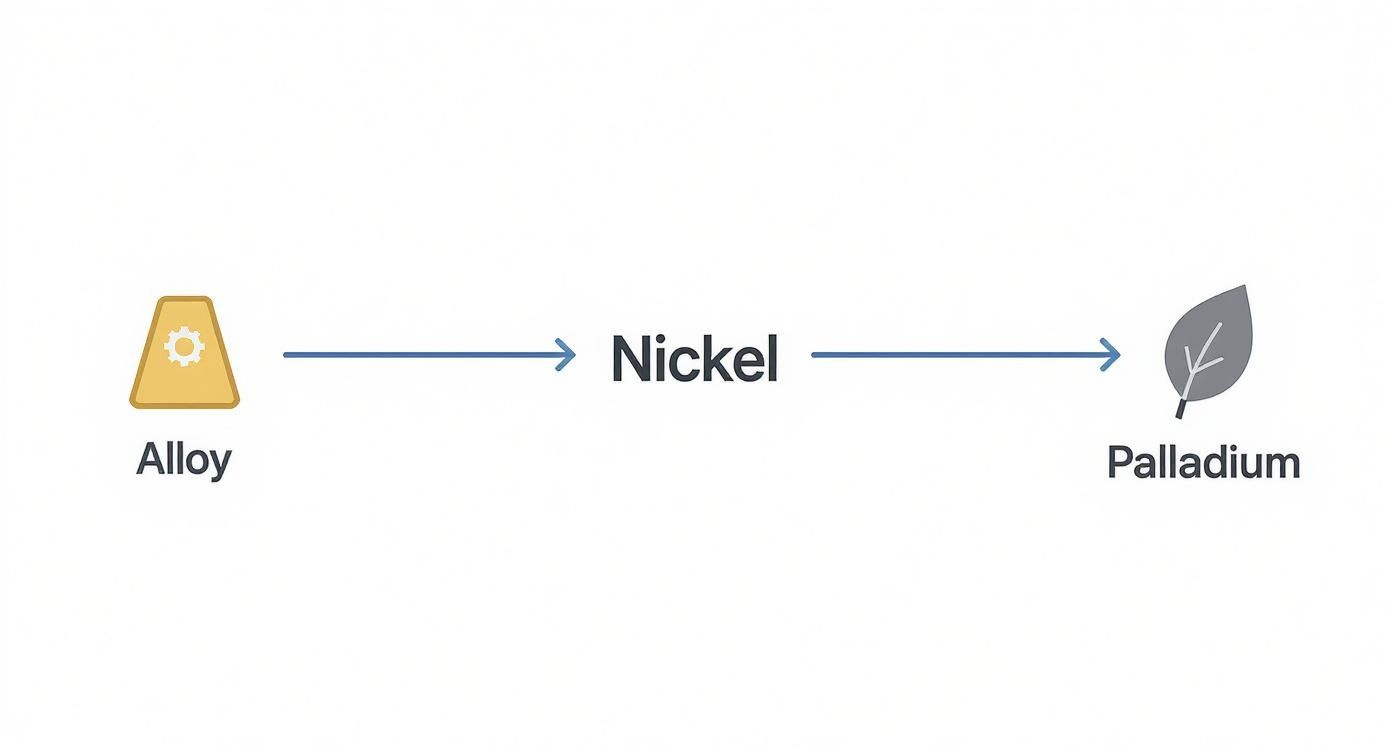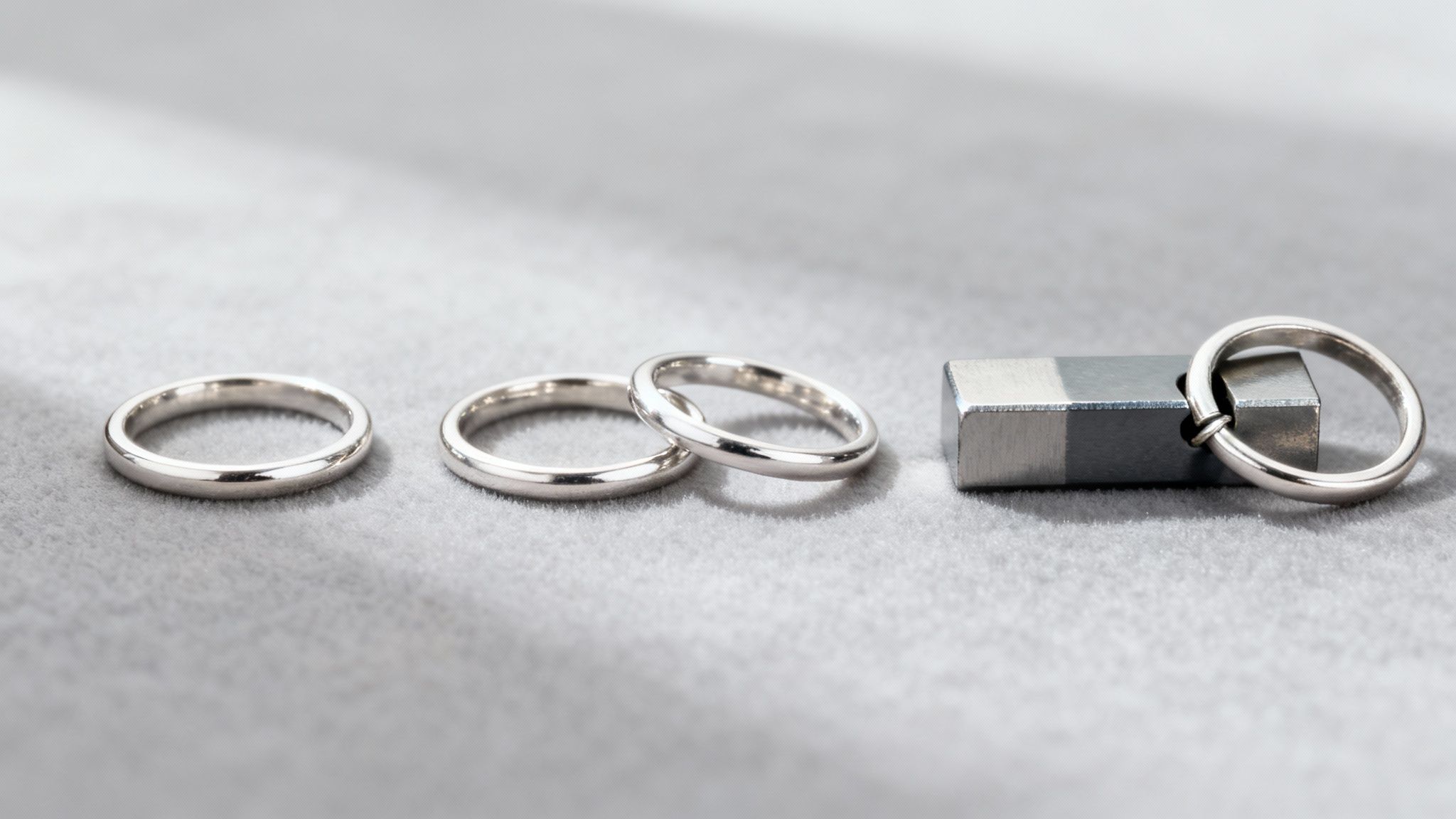Is White Gold Magnetic? The Real Answer for Your Jewelry
- Luke Zucco
- 13 minutes ago
- 9 min read
So, is white gold magnetic? The surprising answer is: sometimes.
While pure gold itself is not magnetic, the metals it’s mixed with can be. This means one piece of white gold jewelry might react to a magnet while another, identical-looking piece won't show any reaction at all. It all comes down to the recipe.
Uncovering White Gold’s Magnetic Secrets

Think of white gold as a unique blend. The main ingredient, pure gold, has zero magnetic properties. In fact, it's technically diamagnetic, which is just a fancy way of saying it slightly repels a magnetic field instead of attracting it. The common misconception that gold is magnetic comes from the other metals added to it, which you can learn more about on the US Gold Bureau's website.
The key to its potential magnetism lies in those other ingredients—the alloys. Jewelers mix in specific white metals to give gold its silvery-white hue and make it strong enough for daily wear. These additions are what can completely change the final piece's magnetic personality.
The Role of Different Alloying Metals
The metals chosen for the alloy recipe are what really determine if your jewelry will stick to a magnet. The two most common metals used to create white gold have opposite effects.
Nickel: A very popular choice for its effectiveness and lower cost. Nickel is a ferromagnetic metal, which means it’s strongly attracted to magnets. When a good amount of nickel is in the mix, it can make the entire piece of jewelry slightly magnetic.
Palladium: This is the premium, hypoallergenic alternative to nickel. Palladium is not magnetic, so any white gold made with it will show absolutely no reaction to a magnet.
Because of these very different recipes, two white gold rings that look exactly alike can behave in completely opposite ways around a magnet. One might give a subtle pull, while the other does nothing. This simple test can actually give you a clue about what metals were used to make your specific piece.
White Gold's Magnetic Properties Based on Alloy
To make it simple, here's a quick breakdown of how common alloying metals affect the magnetism of white gold.
Alloying Metal | Is the Alloy Magnetic? | Primary Reason |
|---|---|---|
Nickel | Yes, often weakly | Nickel is a ferromagnetic (magnetic) metal. |
Palladium | No | Palladium is not magnetic. |
Silver | No | Silver is not magnetic. |
Manganese | No | Manganese is generally not magnetic in alloys. |
Ultimately, a slight magnetic pull doesn't mean your jewelry isn't real white gold—it just tells you a little more about its unique composition.
What Is White Gold, Really?

Before we get into the whole magnet test, it’s important to know that "white gold" isn't a metal you can just dig out of the ground. It’s actually a carefully crafted alloy—a mix of pure yellow gold and other white metals. This blend gives the jewelry its signature silvery-white color and makes it strong enough to handle daily life.
Think of it like a baker’s recipe. Pure gold is your main ingredient, but on its own, it’s way too soft for jewelry. To get that final, durable product, jewelers mix in other metals that not only add strength but also change its color from yellow to white.
At its core, every piece of white gold starts as pure yellow gold. The transformation to its white, lustrous state happens when specific alloying metals are introduced, fundamentally changing its properties—including how it might react to a magnet.
This “recipe” is exactly why the question "is white gold magnetic?" is so interesting. The answer depends entirely on what’s in the mix.
The Key Ingredients in the Mix
The most common metals blended with gold to create that white hue each bring something different to the table. The choice of alloy doesn't just affect the color and durability; it’s the deciding factor in its magnetic potential.
The primary metals used are:
Nickel: This is a popular and budget-friendly choice because it’s great at bleaching the yellow out of gold. But here’s the catch: it's a ferromagnetic metal, meaning it is strongly attracted to magnets.
Palladium: A premium, hypoallergenic option from the platinum family. When you're looking at higher-end pieces, you'll often find palladium, a key component in many high-quality white gold alloys, which is completely non-magnetic.
Silver and Manganese: You’ll see these used sometimes, though not as often as the main bleaching agents. Both are non-magnetic in the amounts used in jewelry.
Of course, the amount of pure gold in the alloy matters, too. If you want to get a better handle on how those percentages work, check out our guide on what percent gold in 10K jewelry actually means.
It's a fascinating rabbit hole. While we all know a solid gold bar isn't magnetic, some recent scientific studies have found that gold can actually show magnetic properties at the nanoscale. It's a cool reminder of just how complex precious metals can be.
Why Some Alloys Create a Magnetic Pull
So, what’s the real culprit behind a magnetic reaction in white gold? The answer almost always comes down to one specific metal in its recipe: nickel. This is the secret ingredient that turns a non-magnetic precious metal into a piece of jewelry that subtly tugs on a magnet.
Pure gold itself couldn't care less about a magnet. It shows no attraction at all. But when you mix in nickel to get that cool, white sheen, it brings its own powerful magnetic properties along for the ride. Nickel is a ferromagnetic metal, meaning it’s strongly attracted to magnetic fields, and it generously shares that trait with the final alloy.
The Nickel vs. Palladium Showdown
Not all white gold is created equal, and this is where the story gets interesting. The choice of alloying metal creates two completely different outcomes when it comes to magnetism, and it’s a decision that dramatically shapes the final piece.
Nickel Alloys: These are incredibly common. Why? Because nickel is an effective and affordable way to bleach the yellow out of gold. A typical 14K white gold nickel alloy might have around 10-12% nickel—usually just enough to cause a faint but noticeable magnetic pull.
Palladium Alloys: Think of palladium as the premium, luxury alternative. It's part of the platinum family, naturally white, hypoallergenic, and most importantly for our test, not magnetic. White gold made with palladium will show zero reaction to a magnet.
This distinction is everything. A little magnetic pull doesn't mean your jewelry is fake. It's just a clue—a little tell-tale sign that nickel is part of its unique formula.
Why Magnetism Strength Varies
Even among white gold pieces made with nickel, the magnetic pull isn't always the same. It all comes down to the concentration of nickel in the mix.
A lower-karat gold, like 10K, actually contains a higher percentage of other metals. That could mean more nickel in the recipe, leading to a stronger and more obvious magnetic response.
A magnetic reaction in white gold is a direct reflection of its alloy. A gentle pull points to a nickel-based recipe, while no reaction at all is a dead giveaway for a palladium blend.
On the flip side, an 18K white gold piece is 75% pure gold, leaving less room for anything else. Even if it uses a nickel alloy, the lower concentration might result in a much weaker, almost imperceptible magnetic pull compared to its 10K or 14K cousins. Think of it like adding a drop of food coloring to a glass of water versus a whole pitcher—the concentration determines how strong the final effect is.
How to Safely Test Your Jewelry with a Magnet
So, you’re curious if your own white gold piece has a magnetic personality? Good news—you can easily run a safe and simple test right at home. This little experiment gives you clues about your jewelry’s specific alloy blend without any risk of damage.
All you need is a magnet that’s a bit stronger than the average fridge decoration. A small neodymium magnet, which you can find at most hardware or craft stores, is perfect for this. They’re powerful enough to pick up on even the slightest magnetic pull.
The Home Magnet Test Step-by-Step
Ready to play detective? The whole process is quick and simple, but follow these steps to make sure you get the most accurate results.
Choose the Right Location: Test the main body of your jewelry. For a ring, that means the band itself. For a necklace, test the chain links.
Approach Slowly: Bring the magnet very close to the item. It’s crucial that you do not let the magnet touch the metal, as a strong one could potentially scratch a soft gold surface.
Observe Carefully: Pay close attention to any sensation you feel. Is there a slight pull between the magnet and your jewelry? Even a faint tug is a positive result.
A common mistake is testing the clasp on a necklace or bracelet. Those clasps almost always contain a tiny steel spring to make the mechanism work, and steel is definitely magnetic. This can give you a false positive, so always stick to testing the main part of the piece.
This whole concept comes down to how gold's non-magnetic nature changes when it's mixed with other metals, specifically nickel or palladium.

As you can see, adding nickel is what introduces magnetism, while using palladium keeps the alloy completely non-magnetic.
Understanding how different karats react is also useful. You can learn more by checking out whether 14K gold is magnetic in our detailed guide. This simple experiment is a practical way to get to know your jewelry’s unique makeup a little better.
What Your Magnet Test Results Reveal

So, you’ve brought a magnet up to your white gold, and now you’re looking at the results. Think of it like a little science experiment—you’ve just collected your first clue about what your jewelry is made of.
Each outcome, whether it’s a strong pull or no reaction at all, points to a different "recipe" of alloys mixed with the gold. Understanding these signals is key to knowing the story and quality behind your piece.
Decoding the Magnetic Reaction
The way your jewelry interacts with the magnet—or doesn't—boils down to a few likely scenarios. Each one tells you something specific about the other metals blended in with the pure gold.
Here’s a quick rundown of what your results probably mean:
No Reaction at All: If the magnet is completely uninterested in your jewelry, you can feel pretty confident it’s made with a palladium alloy. Palladium is a premium, non-magnetic metal from the platinum family, often chosen for being hypoallergenic.
A Faint, Gentle Pull: This is the most common result for white gold. A subtle tug suggests a nickel alloy. Nickel itself is magnetic, but because it’s mixed with a high percentage of non-magnetic gold, you only get a weak attraction.
A Very Strong Pull: Okay, if the magnet latches on tight, it’s time to look a little closer. While it could mean the piece has a very high concentration of nickel, it can also be a red flag. A strong pull sometimes indicates the item is just gold-plated over a highly magnetic base like iron or steel.
To make it even clearer, here’s a simple table to help you interpret what you're seeing.
Magnet Test Results and What They Mean
Test Outcome | Likely Alloy Composition | What This Indicates |
|---|---|---|
No Attraction | High-purity gold with palladium | This is common in high-end, hypoallergenic white gold. |
Weak Attraction | High-purity gold with nickel | This is a very common and expected result for most white gold jewelry. |
Strong Attraction | Lower-purity gold with a lot of nickel, or a magnetic base metal | This warrants a closer look. It might be a fake or gold-plated item. |
This quick guide should help you make sense of that little magnetic tug, or the lack of one.
The magnet test is an insightful first step, not a final verdict. It's a fantastic home experiment that reveals clues about your jewelry's alloys, but it doesn't replace a professional appraisal for definitive purity analysis.
This simple test is just one of several ways you can investigate your pieces. To learn about other methods, check out our guide on how to tell real jewelry from fake. Ultimately, figuring out if your white gold is magnetic helps you better understand the materials and craftsmanship that make your jewelry unique.
Common Questions About White Gold Jewelry
Alright, so we’ve dug into the science of what makes some white gold magnetic. But what does that actually mean for you and the jewelry you wear every day? Let's tackle a couple of the most common questions people have.
Knowing these details can make all the difference in how you choose, wear, and care for your pieces.
Is Magnetic White Gold More Likely to Cause an Allergy?
In a word, yes. The magnetism in white gold comes from its nickel content, and nickel happens to be the number one culprit behind metal allergies. If you have sensitive skin that gets red or itchy with certain jewelry, a magnetic piece of white gold is far more likely to be the problem.
This is exactly why palladium white gold has become such a popular choice. It’s naturally hypoallergenic and non-magnetic, making it a much safer bet for anyone with a known nickel sensitivity. Think of the magnet test as a quick, easy way to screen for potentially irritating jewelry before you even put it on.
A magnetic pull is a dead giveaway for a nickel alloy. If you have sensitive skin, always opt for non-magnetic white gold—usually a palladium blend. You get all the style and durability without the risk of an allergic reaction.
Can a Strong Magnet Damage White Gold Jewelry?
You can relax on this one—a magnet will not damage your white gold jewelry. The magnetic force in nickel-based white gold is incredibly weak. It’s just not strong enough to bend, discolor, or structurally harm the metal in any way.
Even if you use a powerful neodymium magnet for testing, it’s perfectly safe to bring it near your jewelry. The pull you feel is just a temporary attraction that tells you nickel is present. Nothing more.
And while we're on the topic of caring for your pieces, you might be interested in showcasing them beautifully. For that, you can find some great professional jewelry photography tips that come in handy for insurance records or just sharing your collection online. The main takeaway here is that magnetism is a harmless trait, not a flaw.
At Panther De Luxe Shop, we offer a stunning collection of finely crafted jewelry designed for every style. Explore our collections today to find your next favorite piece at https://www.pantherdeluxe.com.

Comments